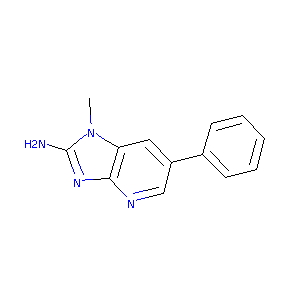Details of the Drug
General Information of Drug (ID: DMNQL17)
| Drug Name |
2-AMINO-1-METHYL-6-PHENYLIMIDAZO[4,5-B]PYRIDINE
|
||||||||||||||||||||||
|---|---|---|---|---|---|---|---|---|---|---|---|---|---|---|---|---|---|---|---|---|---|---|---|
| Synonyms |
PhIP; 105650-23-5; 2-amino-1-methyl-6-phenylimidazo[4,5-b]pyridine; 1-methyl-6-phenyl-1H-imidazo[4,5-b]pyridin-2-amine; 2-Amino-1-methyl-6-phenylimidazo(4,5-b)pyridine; UNII-909C6UN66T; CHEBI:76290; 909C6UN66T; 1-Methyl-6-phenyl-1H-imidazo(4,5-b)pyridin-2-amine; PIQ; 2-AMINO-1-METHYL-6-PHENYL-IMIDAZO [4,5-b] PYRIDINE; 1H-Imidazo(4,5-b)pyridin-2-amine, 1-methyl-6-phenyl- (9CI); CCRIS 2954; HSDB 7768; BRN 5951264; ACMC-1BRGI; AC1Q4WMI; (3H)PhIP; AC1L1BO3; SCHEMBL151718; CHEMBL1213271; DTXSID3037628; CTK0I0185
|
||||||||||||||||||||||
| Indication |
|
||||||||||||||||||||||
| Drug Type |
Small molecular drug
|
||||||||||||||||||||||
| Structure |
 |
||||||||||||||||||||||
| 3D MOL | 2D MOL | ||||||||||||||||||||||
| #Ro5 Violations (Lipinski): 0 | Molecular Weight (mw) | 224.26 | |||||||||||||||||||||
| Logarithm of the Partition Coefficient (xlogp) | 2.2 | ||||||||||||||||||||||
| Rotatable Bond Count (rotbonds) | 1 | ||||||||||||||||||||||
| Hydrogen Bond Donor Count (hbonddonor) | 1 | ||||||||||||||||||||||
| Hydrogen Bond Acceptor Count (hbondacc) | 3 | ||||||||||||||||||||||
| Chemical Identifiers |
|
||||||||||||||||||||||
| Cross-matching ID | |||||||||||||||||||||||
Molecular Interaction Atlas of This Drug
 Drug Therapeutic Target (DTT) |
|
|||||||||||||||||||||||||||||||||||||||||||||||||||||||||||||||||||||||
|---|---|---|---|---|---|---|---|---|---|---|---|---|---|---|---|---|---|---|---|---|---|---|---|---|---|---|---|---|---|---|---|---|---|---|---|---|---|---|---|---|---|---|---|---|---|---|---|---|---|---|---|---|---|---|---|---|---|---|---|---|---|---|---|---|---|---|---|---|---|---|---|---|
 Drug-Metabolizing Enzyme (DME) |
|
|||||||||||||||||||||||||||||||||||||||||||||||||||||||||||||||||||||||
 Drug Off-Target (DOT) |
|
|||||||||||||||||||||||||||||||||||||||||||||||||||||||||||||||||||||||
| Molecular Interaction Atlas (MIA) | ||||||||||||||||||||||||||||||||||||||||||||||||||||||||||||||||||||||||
References
